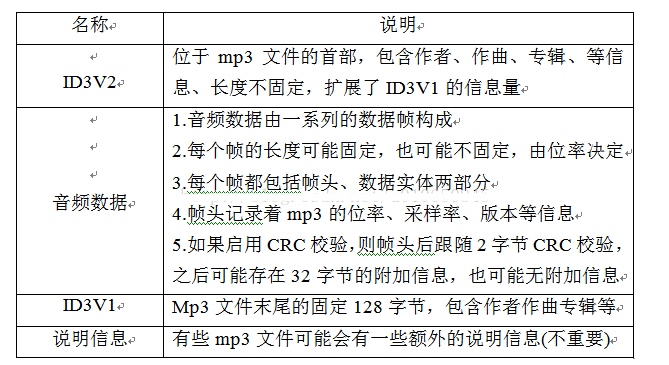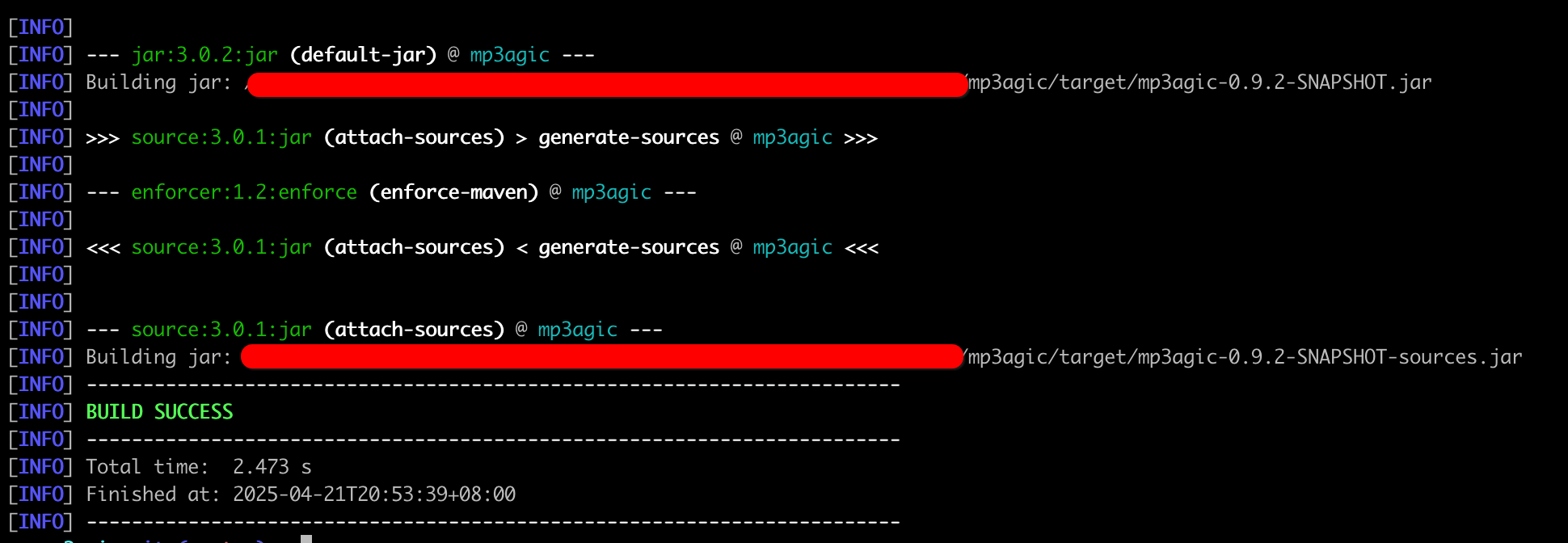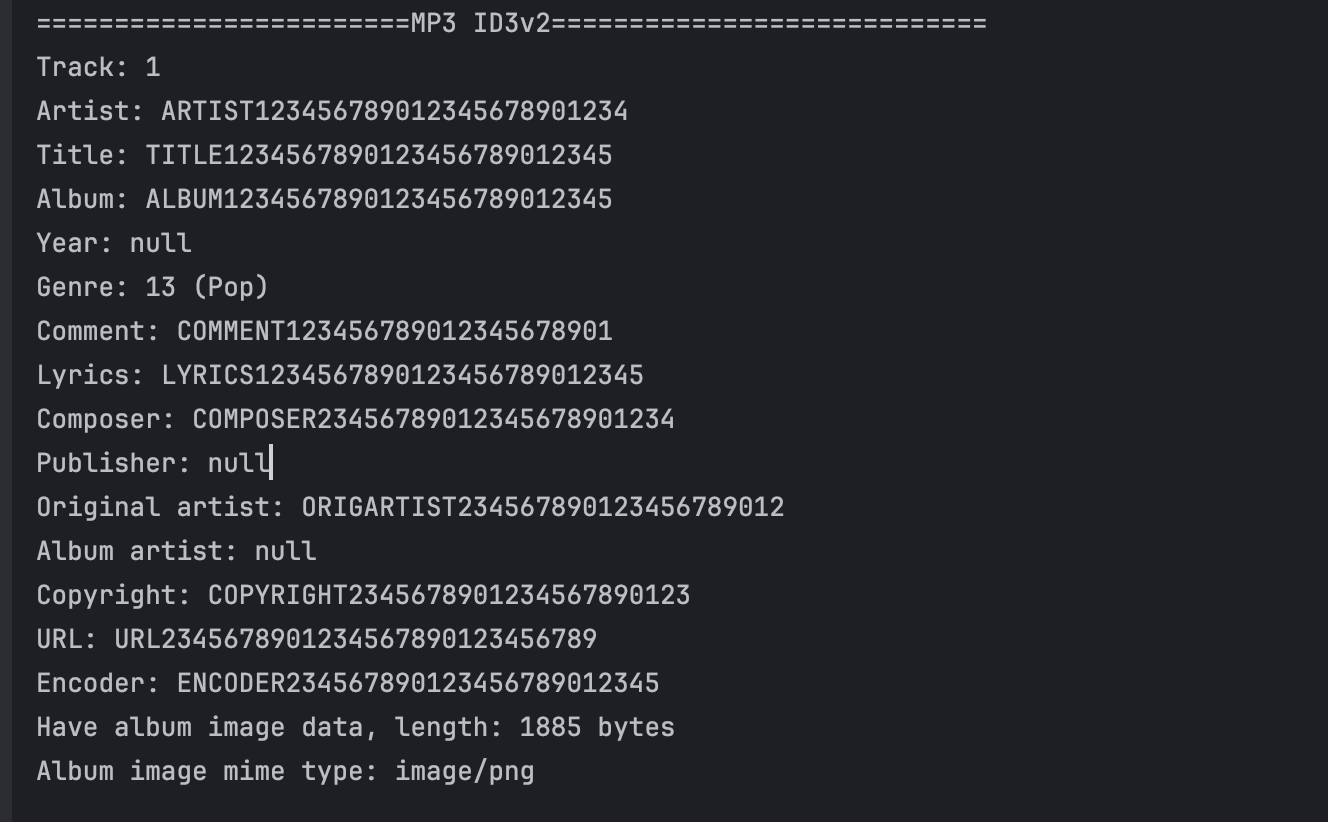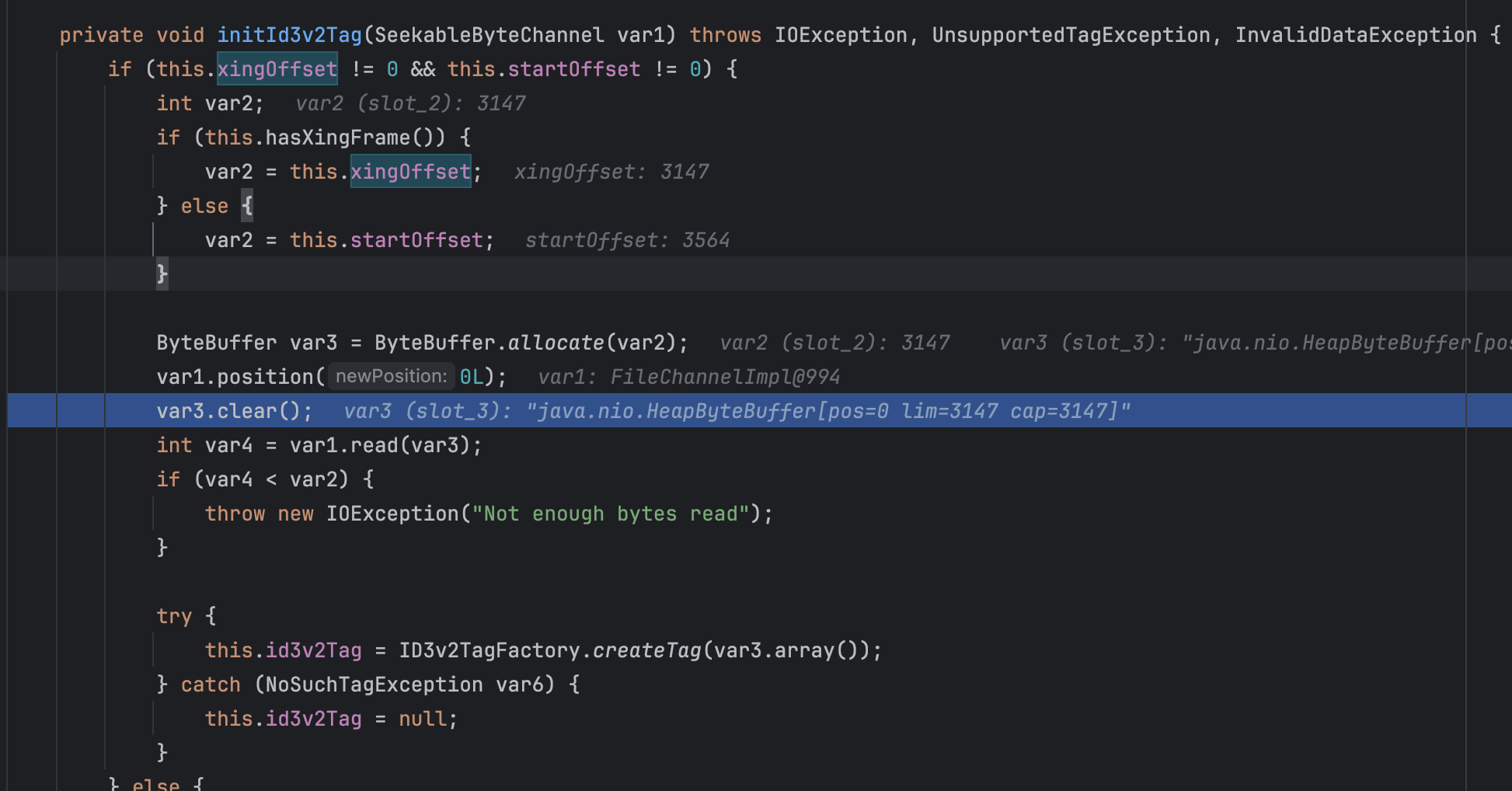环境
JDK 13
IDEA Build #IC-243.26053.27, built on March 16, 2025
Demo
MP3Parser
MP3
MP3全称为MPEG Audio Layer 3,它是一种高效的计算机音频编码方案,它以较大的压缩比将音频文件转换成较小的扩展名为.mp3的文件,基本保持源文件的音质,MP3是ISO/MPEG标准的一部分,
ISO/MPEG标准描述了使用高性能感知编码方案的音频压缩,此标准一直在不断更新以满足“质高量小”的追求,现已形成MPEG Layer1、Layer2、Layer3三种音频编解码方案,分别对应MP1、MP2、MP3 这三种声音文件
了解下MP3的编码方式
静态码率(CBR):Constants Bits Rate是一种固定采样率的压缩方式
这种编码方式不需要文件头,第一帧开始就是音频数据
(1)优点:压缩快,能被大多数软件和设备支持。
(2)缺点:占用空间大,效果不是十分理想。现已逐渐被VBR方式取代。
动态码率(VBR):Variable Bit Rate使用这个方式时,可以选择从最差音质/最大压缩比到最好音质/最低压缩比之间的种种过渡级数,在MP3文件编码之时,程序会尝试保持所选定的整个文件的品质,将选择适合音乐文件不同部分的不同比特率来编码。
需要文件头
(1)优点:可以让整首歌都能大致达到我们的音质要求。
(2)缺点:编码时无法估计压缩出来的文件体积大小
文件结构
一般可分为以下三部分
来自参考3

配合具体的解析的开源工程来理解
mp3agic-Java写的读写mp3的开源库
因为工程是以前的,遇到些问题,费了些时间,编译出mp3agic的jar包

查看该工具加载MP3文件代码,从中也可以看出,分成Id3v1,音频,Id3v2和自定义的部分
1
2
3
4
5
6
7
8
9
10
11
12
13
14
15
16
17
18
19
20
21
22
23
24
25
26
|
private void init(int bufferLength, boolean scanFile) throws IOException, UnsupportedTagException, InvalidDataException {
if (bufferLength < MINIMUM_BUFFER_LENGTH + 1) throw new IllegalArgumentException("Buffer too small");
this.bufferLength = bufferLength;
this.scanFile = scanFile;
try (SeekableByteChannel seekableByteChannel = Files.newByteChannel(path, StandardOpenOption.READ)) {
initId3v1Tag(seekableByteChannel);
scanFile(seekableByteChannel);
if (startOffset < 0) {
throw new InvalidDataException("No mpegs frames found");
}
initId3v2Tag(seekableByteChannel);
if (scanFile) {
initCustomTag(seekableByteChannel);
}
}
}
|
ID3V1
ID3 V1.0标准并不周全,存放的信息少,无法存放歌词,无法录入专辑封面、图片等。
此标准是将MP3文件尾的最后128个字节用来存放ID3信息
| 字节 |
长度(字节) |
说明 |
| 1-3 |
3 |
存放”TAG”字符,表示ID3V1.0标准,紧接其后的是歌曲信息 |
| 4-33 |
30 |
歌名 |
| 34-63 |
30 |
作者 |
| 64-93 |
30 |
专辑名 |
| 94-97 |
4 |
年份 |
| 98-127 |
30 |
附注 |
| 128 |
1 |
MP3音乐类别,共147种 |
音乐类型具体可以看 ID3v1Geners.java中定义的枚举或者本文后的参考3
1
2
3
4
5
6
7
8
9
10
11
12
13
14
15
16
17
18
19
20
21
22
23
24
25
| 0="Blues";
1="ClassicRock";
2="Country";
3="Dance";
4="Disco";
5="Funk";
6="Grunge";
7="Hip-Hop";
8="Jazz";
9="Metal";
10="NewAge";
11="Oldies";
12="Other";
13="Pop";
14="R&B";
15="Rap";
16="Reggae";
17="Rock";
18="Techno";
...
143="Salsa";
144="Trashl";
145="Anime";
146="JPop";
147="Synthpop";
|
验证
1
2
3
4
5
6
7
8
|
public class Main {
public static void main(String[] args) throws InvalidDataException, UnsupportedTagException, IOException {
Main parse = new Main();
String filename = "resource/v24tagswithalbumimage.mp3";
...
}
}
|
1
2
3
4
5
6
7
8
9
10
11
12
13
14
| public void getID3v1Tag (String filename) throws InvalidDataException, UnsupportedTagException, IOException {
System.out.println("\n========================MP3 ID3v1============================");
Mp3File mp3file = new Mp3File(filename);
if (mp3file.hasId3v1Tag()) {
ID3v1 id3v1Tag = mp3file.getId3v1Tag();
System.out.println("Track: " + id3v1Tag.getTrack());
System.out.println("Artist: " + id3v1Tag.getArtist());
System.out.println("Title: " + id3v1Tag.getTitle());
System.out.println("Album: " + id3v1Tag.getAlbum());
System.out.println("Year: " + id3v1Tag.getYear());
System.out.println("Genre: " + id3v1Tag.getGenre() + " (" + id3v1Tag.getGenreDescription() + ")");
System.out.println("Comment: " + id3v1Tag.getComment());
}
}
|

1
2
3
4
5
6
7
8
9
10
11
12
13
14
15
16
17
18
19
20
21
22
23
| private void initId3v1Tag(SeekableByteChannel var1) throws IOException {
ByteBuffer var2 = ByteBuffer.allocate(128);
var1.position(this.getLength() - 128L);
var2.clear();
int var3 = var1.read(var2);
if (var3 < 128) {
throw new IOException("Not enough bytes read");
} else {
try {
this.id3v1Tag = new ID3v1Tag(var2.array());
} catch (NoSuchTagException var5) {
this.id3v1Tag = null;
}
}
}
|
1
2
3
4
5
6
7
8
9
10
11
12
13
14
15
16
17
18
19
20
21
22
23
24
25
26
27
28
29
| private void unpackTag(byte[] var1) throws NoSuchTagException {
this.sanityCheckTag(var1);
this.title = BufferTools.trimStringRight(BufferTools.byteBufferToStringIgnoringEncodingIssues(var1, 3, 30));
this.artist = BufferTools.trimStringRight(BufferTools.byteBufferToStringIgnoringEncodingIssues(var1, 33, 30));
this.album = BufferTools.trimStringRight(BufferTools.byteBufferToStringIgnoringEncodingIssues(var1, 63, 30));
this.year = BufferTools.trimStringRight(BufferTools.byteBufferToStringIgnoringEncodingIssues(var1, 93, 4));
this.genre = var1[127] & 255;
if (this.genre == 255) {
this.genre = -1;
}
if (var1[125] != 0) {
this.comment = BufferTools.trimStringRight(BufferTools.byteBufferToStringIgnoringEncodingIssues(var1, 97, 30));
this.track = null;
} else {
this.comment = BufferTools.trimStringRight(BufferTools.byteBufferToStringIgnoringEncodingIssues(var1, 97, 28));
byte var2 = var1[126];
if (var2 == 0) {
this.track = "";
} else {
this.track = Integer.toString(var2);
}
}
}
|
1
2
3
4
5
6
7
8
|
public static String byteBufferToStringIgnoringEncodingIssues(byte[] var0, int var1, int var2) {
try {
return byteBufferToString(var0, var1, var2, defaultCharsetName);
} catch (UnsupportedEncodingException var4) {
return null;
}
}
|
音频帧
来自参考1
每个帧都有一个帧头,长度是四个字节,帧后面可能有2字节的CRC校验,取决于帧头的第16位,为0则无校验,为1则有校验,后面是可变长度的附加信息,对于标准的MP3文件来说,其长度是32字节,紧接其后的是压缩的声音数据,当解码器读到此处时就进行解码了。
| 名称 |
长度(字节) |
属性 |
| 帧头 |
4 |
必存在 |
| CRC |
2 |
可能存在 |
| Side Info |
32 |
必存在 |
| 声音数据 |
N |
必存在 |
1
2
3
4
5
6
7
8
9
10
11
12
13
14
15
| typedef FrameHeader {
unsigned int sync:11;
unsigned int version:2;
unsigned int layer: 2;
unsigned int error protection:1;
unsigned int bitrate_index:4;
unsigned int sampling_frequency:2;
unsigned int padding:1;
unsigned int private:1;
unsigned int mode:2;
unsigned int mode extension:2;
unsigned int copyright:1;
unsigned int original:1;
unsigned int emphasis:2;
}HEADER, *LPHEADER;
|
| 名称 |
位长 |
第几字节 |
说明 |
| 同步信息 |
11 |
1~2 |
所有位均为1,第1字节恒为FF |
| 版本 |
2 |
2 |
00-MPEG 2.5 01-未定义 10-MPEG2 11-MPEG 1 |
| 层 |
2 |
2 |
00-未定义 01-Layer 3 10-Layer 2 11-Layer 1 |
| CRC校验 |
1 |
2 |
0-校验 1-不校验 |
| 位率 |
4 |
3 |
取样率,单位为kbs。详见下表 |
| 采样频率 |
2 |
3 |
MPEG-1: 00:44.1kHz 01:48kHz 10:32kHz 11-未定义 |
|
|
|
MPEG-2: 00:22.05kHz 01:24kHz 10:16kHz 11-未定义 |
|
|
|
MPEG-2.5: 00:11.025kHz 01:12kHz 10:8kHz 11-未定义 |
| 帧长调节 |
1 |
3 |
用于调整文件头长度,0:无需调整 1:调整 |
| 保留字 |
1 |
3 |
没有使用 |
| 声道模式 |
2 |
4 |
00:立体声Stereo 01:Joint Stereo 10:双声道 11:单声道 |
| 扩充模式 |
2 |
4 |
当声道模式为01时才使用 |
| 版权 |
1 |
4 |
0:不合法 1:合法 |
| 原版标志 |
1 |
4 |
是否原版, 0: 非原版,1:原版 |
| 强调方式 |
2 |
4 |
用于声音降噪压缩后再补偿的分类,很少用到 |
位率
V1: MPEG 1
V2: MPEG 2 和 MPEG 2.5
L1: Layer 1
L2: Lyaer 2
L3: Layer 3
| bits |
V1,L1 |
V1,L2 |
V1,L3 |
V2,L1 |
V2,L2 |
V2,L3 |
| 0000 |
free |
free |
free |
free |
free |
free |
| 0001 |
32 |
32 |
32 |
32(32) |
32(8) |
8(8) |
| 0010 |
64 |
48 |
40 |
64(48) |
48(16) |
16(16) |
| 0011 |
96 |
56 |
48 |
96(56) |
56(24) |
24(24) |
| 0100 |
128 |
64 |
56 |
128(64) |
64(32) |
32(32) |
| 0101 |
160 |
80 |
64 |
160(80) |
80(40) |
64(40) |
| 0110 |
192 |
96 |
80 |
192(96) |
96(48) |
80(48) |
| 0111 |
224 |
112 |
96 |
224(112) |
112(56) |
56(56) |
| 1000 |
256 |
128 |
112 |
256(128) |
128(64) |
64(64) |
| 1001 |
288 |
160 |
128 |
288(144) |
160(80) |
128(80) |
| 1010 |
320 |
192 |
160 |
320(160) |
192(96) |
160(96) |
| 1011 |
352 |
224 |
192 |
356(176) |
224(112) |
112(112) |
| 1100 |
384 |
256 |
224 |
384(192) |
256(128) |
128(128) |
| 1101 |
416 |
320 |
256 |
416(224) |
320(144) |
256(144) |
| 1110 |
448 |
384 |
320 |
448(256) |
384(160) |
320(160) |
| 1111 |
bad |
bad |
bad |
bad |
bad |
bad |
帧大小即每帧的采样数,表示一帧数据中采样的个数,该值是恒定的
MP3的帧大小是1152
帧长度是压缩时每一帧的长度,包括帧头的4个字节。它将填充的空位也计算在内。Layer 2和Layer 3的空位是1字节。当读取MPEG文件时必须计算该值以便找到相邻的帧
计算公式:
1
| Layer2/3:Len(字节) = ((每帧采样数/8*比特率)/采样频率)+填充
|
例:MPEG1 Layer3 比特率128000,采样率44100,填充0,帧长度为:((1152/8*128K)/44.1K+0=417字节
帧持续时间
计算公式:
1
| 每帧持续时间(毫秒) = 每帧采样数 / 采样频率 * 1000
|
例:1152/441000*1000=26ms
帧头后边是Side Info。对标准的立体声MP3文件来说其长度为32字节。当解码器在读到上述信息后,就可以进行解码了
验证
读取音频数据帧头
1
2
3
4
5
6
|
...
scanFile(seekableByteChannel);
...
|
1
2
3
4
5
6
7
8
9
10
11
12
13
14
15
16
17
18
19
20
21
22
23
24
25
26
27
28
29
30
31
32
33
34
35
36
37
38
39
40
41
42
43
44
45
46
47
48
49
50
51
52
53
|
private void scanFile(SeekableByteChannel seekableByteChannel) throws IOException, InvalidDataException {
ByteBuffer byteBuffer = ByteBuffer.allocate(bufferLength);
int fileOffset = preScanFile(seekableByteChannel);
seekableByteChannel.position(fileOffset);
boolean lastBlock = false;
int lastOffset = fileOffset;
while (!lastBlock) {
byteBuffer.clear();
int bytesRead = seekableByteChannel.read(byteBuffer);
byte[] bytes = byteBuffer.array();
if (bytesRead < bufferLength) lastBlock = true;
if (bytesRead >= MINIMUM_BUFFER_LENGTH) {
while (true) {
try {
int offset = 0;
if (startOffset < 0) {
offset = scanBlockForStart(bytes, bytesRead, fileOffset, offset);
if (startOffset >= 0 && !scanFile) {
return;
}
lastOffset = startOffset;
}
offset = scanBlock(bytes, bytesRead, fileOffset, offset);
fileOffset += offset;
seekableByteChannel.position(fileOffset);
break;
} catch (InvalidDataException e) {
if (frameCount < 2) {
startOffset = -1;
xingOffset = -1;
frameCount = 0;
bitrates.clear();
lastBlock = false;
fileOffset = lastOffset + 1;
if (fileOffset == 0)
throw new InvalidDataException("Valid start of mpeg frames not found", e);
seekableByteChannel.position(fileOffset);
break;
}
return;
}
}
}
}
}
|
<1> 获取文件偏移量
1
2
3
4
5
6
7
8
9
10
11
12
13
14
15
16
17
18
19
20
21
22
| protected int preScanFile(SeekableByteChannel seekableByteChannel) {
ByteBuffer byteBuffer = ByteBuffer.allocate(AbstractID3v2Tag.HEADER_LENGTH);
try {
seekableByteChannel.position(0);
byteBuffer.clear();
int bytesRead = seekableByteChannel.read(byteBuffer);
if (bytesRead == AbstractID3v2Tag.HEADER_LENGTH) {
try {
byte[] bytes = byteBuffer.array();
ID3v2TagFactory.sanityCheckTag(bytes);
return AbstractID3v2Tag.HEADER_LENGTH + BufferTools.unpackSynchsafeInteger(bytes[AbstractID3v2Tag.DATA_LENGTH_OFFSET], bytes[AbstractID3v2Tag.DATA_LENGTH_OFFSET + 1], bytes[AbstractID3v2Tag.DATA_LENGTH_OFFSET + 2], bytes[AbstractID3v2Tag.DATA_LENGTH_OFFSET + 3]);
} catch (NoSuchTagException | UnsupportedTagException e) {
}
}
} catch (IOException e) {
}
return 0;
}
|
规则代码如下
1
2
3
4
5
6
7
8
9
10
11
12
13
14
15
16
17
18
19
20
21
22
23
24
| public static int shiftByte(byte c, int places) {
int i = c & 0xff;
if (places < 0) {
return i << -places;
} else if (places > 0) {
return i >> places;
}
return i;
}
public static int unpackSynchsafeInteger(byte b1, byte b2, byte b3, byte b4) {
int value = ((byte) (b4 & 0x7f));
value += shiftByte((byte) (b3 & 0x7f), -7);
value += shiftByte((byte) (b2 & 0x7f), -14);
value += shiftByte((byte) (b1 & 0x7f), -21);
return value;
}
|
<2>音频首帧的处理
1
2
3
4
5
6
7
8
9
10
11
12
13
14
15
16
17
18
19
20
21
22
23
24
25
26
27
28
29
30
31
32
33
34
35
36
37
38
39
| private int scanBlockForStart(byte[] bytes, int bytesRead, int absoluteOffset, int offset) {
while (offset < bytesRead - MINIMUM_BUFFER_LENGTH) {
if (bytes[offset] == (byte) 0xFF && (bytes[offset + 1] & (byte) 0xE0) == (byte) 0xE0) {
try {
MpegFrame frame = new MpegFrame(bytes[offset], bytes[offset + 1], bytes[offset + 2], bytes[offset + 3]);
if (xingOffset < 0 && isXingFrame(bytes, offset)) {
xingOffset = absoluteOffset + offset;
xingBitrate = frame.getBitrate();
offset += frame.getLengthInBytes();
} else {
startOffset = absoluteOffset + offset;
channelMode = frame.getChannelMode();
emphasis = frame.getEmphasis();
layer = frame.getLayer();
modeExtension = frame.getModeExtension();
sampleRate = frame.getSampleRate();
version = frame.getVersion();
copyright = frame.isCopyright();
original = frame.isOriginal();
frameCount++;
addBitrate(frame.getBitrate());
offset += frame.getLengthInBytes();
return offset;
}
} catch (InvalidDataException e) {
offset++;
}
} else {
offset++;
}
}
return offset;
}
|
这里按音频帧头的格式填充
1
2
3
4
5
6
7
8
9
10
11
12
13
14
15
16
17
18
19
20
21
22
| public MpegFrame(byte frameData1, byte frameData2, byte frameData3, byte frameData4) throws InvalidDataException {
long frameHeader = BufferTools.unpackInteger(frameData1, frameData2, frameData3, frameData4);
setFields(frameHeader);
}
private void setFields(long frameHeader) throws InvalidDataException {
long frameSync = extractField(frameHeader, BITMASK_FRAME_SYNC);
if (frameSync != FRAME_SYNC) throw new InvalidDataException("Frame sync missing");
setVersion(extractField(frameHeader, BITMASK_VERSION));
setLayer(extractField(frameHeader, BITMASK_LAYER));
setProtection(extractField(frameHeader, BITMASK_PROTECTION));
setBitRate(extractField(frameHeader, BITMASK_BITRATE));
setSampleRate(extractField(frameHeader, BITMASK_SAMPLE_RATE));
setPadding(extractField(frameHeader, BITMASK_PADDING));
setPrivate(extractField(frameHeader, BITMASK_PRIVATE));
setChannelMode(extractField(frameHeader, BITMASK_CHANNEL_MODE));
setModeExtension(extractField(frameHeader, BITMASK_MODE_EXTENSION));
setCopyright(extractField(frameHeader, BITMASK_COPYRIGHT));
setOriginal(extractField(frameHeader, BITMASK_ORIGINAL));
setEmphasis(extractField(frameHeader, BITMASK_EMPHASIS));
}
|
判断是否是”Xing”帧
1
2
3
4
5
6
7
8
9
10
11
12
13
14
15
16
17
18
19
20
21
| private boolean isXingFrame(byte[] bytes, int offset) {
if (bytes.length >= offset + XING_MARKER_OFFSET_1 + 3) {
if ("Xing".equals(BufferTools.byteBufferToStringIgnoringEncodingIssues(bytes, offset + XING_MARKER_OFFSET_1, 4)))
return true;
if ("Info".equals(BufferTools.byteBufferToStringIgnoringEncodingIssues(bytes, offset + XING_MARKER_OFFSET_1, 4)))
return true;
if (bytes.length >= offset + XING_MARKER_OFFSET_2 + 3) {
if ("Xing".equals(BufferTools.byteBufferToStringIgnoringEncodingIssues(bytes, offset + XING_MARKER_OFFSET_2, 4)))
return true;
if ("Info".equals(BufferTools.byteBufferToStringIgnoringEncodingIssues(bytes, offset + XING_MARKER_OFFSET_2, 4)))
return true;
if (bytes.length >= offset + XING_MARKER_OFFSET_3 + 3) {
if ("Xing".equals(BufferTools.byteBufferToStringIgnoringEncodingIssues(bytes, offset + XING_MARKER_OFFSET_3, 4)))
return true;
if ("Info".equals(BufferTools.byteBufferToStringIgnoringEncodingIssues(bytes, offset + XING_MARKER_OFFSET_3, 4)))
return true;
}
}
}
return false;
}
|
<3>读取音频帧
1
2
3
4
5
6
7
8
9
10
11
12
13
14
15
16
17
18
19
| private int scanBlock(byte[] bytes, int bytesRead, int absoluteOffset, int offset) throws InvalidDataException {
while (offset < bytesRead - MINIMUM_BUFFER_LENGTH) {
MpegFrame frame = new MpegFrame(bytes[offset], bytes[offset + 1], bytes[offset + 2], bytes[offset + 3]);
sanityCheckFrame(frame, absoluteOffset + offset);
int newEndOffset = absoluteOffset + offset + frame.getLengthInBytes() - 1;
if (newEndOffset < maxEndOffset()) {
endOffset = absoluteOffset + offset + frame.getLengthInBytes() - 1;
frameCount++;
addBitrate(frame.getBitrate());
offset += frame.getLengthInBytes();
} else {
break;
}
}
return offset;
}
|
ID3V2
ID3V2一共有四个版本,ID3V2.1/2.2/2.3/2.4
ID3V2.3由一个标签头和若干个标签帧或者一个扩展标签头组成,至少要有一个标签帧,每一个标签帧记录一种信息,例如作曲、标题等
标签头
位于文件开始处,长度为10字节
1
2
3
4
5
6
7
8
9
10
11
12
13
| char Header[3];
char Ver;
char Revision;
char Flag;
char Size[4];
|
标签帧
每个标签帧都有10个字节的帧头和至少一个字节的内容构成
1
2
3
4
5
6
7
8
9
10
11
12
13
14
15
16
17
18
|
char ID[4];
char Size[4];
char Flags[2];
|
验证
打印MP3文件中的Id3v2
1
2
3
4
5
6
7
8
9
10
11
12
13
14
15
16
17
18
19
20
21
22
23
24
25
26
27
28
29
| ...
public void getID3v2Tag(String filename) throws InvalidDataException, UnsupportedTagException, IOException {
System.out.println("\n========================MP3 ID3v2============================");
Mp3File mp3file = new Mp3File(filename);
if (mp3file.hasId3v2Tag()) {
ID3v2 id3v2Tag = mp3file.getId3v2Tag();
System.out.println("Track: " + id3v2Tag.getTrack());
System.out.println("Artist: " + id3v2Tag.getArtist());
System.out.println("Title: " + id3v2Tag.getTitle());
System.out.println("Album: " + id3v2Tag.getAlbum());
System.out.println("Year: " + id3v2Tag.getYear());
System.out.println("Genre: " + id3v2Tag.getGenre() + " (" + id3v2Tag.getGenreDescription() + ")");
System.out.println("Comment: " + id3v2Tag.getComment());
System.out.println("Lyrics: " + id3v2Tag.getLyrics());
System.out.println("Composer: " + id3v2Tag.getComposer());
System.out.println("Publisher: " + id3v2Tag.getPublisher());
System.out.println("Original artist: " + id3v2Tag.getOriginalArtist());
System.out.println("Album artist: " + id3v2Tag.getAlbumArtist());
System.out.println("Copyright: " + id3v2Tag.getCopyright());
System.out.println("URL: " + id3v2Tag.getUrl());
System.out.println("Encoder: " + id3v2Tag.getEncoder());
byte[] albumImageData = id3v2Tag.getAlbumImage();
if (albumImageData != null) {
System.out.println("Have album image data, length: " + albumImageData.length + " bytes");
System.out.println("Album image mime type: " + id3v2Tag.getAlbumImageMimeType());
}
}
}
...
|
结果如下

从网上下载的一些mp3文件因为是静态码率,所以没有标签头,用Sublime Text打开后就是

用FFmpeg把pcm压缩编码为mp3会加上
1
| $ ffmpeg -y -i v24tagswithalbumimage.mp3 -acodec pcm_s16le -f s16le -ac 2 -ar 44100 v24tagswithalbumimage.pcm
|
v24tagswithalbumimage.mp3文件的二进制
标签头

Header[3] + Version是4944 3304:就是 ID3v2和 第4版
Revision:0
Flag:0 不使用Unsynchronisation,没有扩展头,非测试标签
Size[4]是1841根据上面提到的公式
1
| Size = (Size[0] & 0x7F) * 0x200000 + (Size[1] & 0x7F) * 0x400+(Size[2] & 0x7F) * 0x80 + (Size[3] & 0x7F)
|
计算: (0x18 & 0x7F) * 0x80 + (0x41 & 0x7F)
= 0x18 * 0x80 + 0x41
= 3137
加上头的10个字节,所以mp3文件的ID3v2部分是 3147
这个调试的时候也可以验证

var1 是mp3文件, var3 是被认为ID3v2的内容。
寻找首个音频帧
1
2
3
4
5
| // 根据ID3v2的size + 上面的公式 + ID3v2的文件头
0x1841 => 0x41 + 0x18 << 7 = 3137
3137 + 10 = 3147
3147 = 196 * 16 + 11
|

根据前4个字节 0xfffb9044
0b1111 1111 111/ 11 / 01 / 0 / 1001 / 00 / 0 / 0 / 01 / 00 0 / 1 / 00
同步信息: 0xfffb 前11个都是1
版本:11-说明是MPEG 1
层:01-说明是Layer 3 是MP3符合预期
CRC: 0 不校验
位率: 1001,因为是MPEG 1 + Layer 3,根据上面的码表 取样率:128kbps
采样率: 00,因为是MPEG 1说明是44.1kHz
帧长调节: 0,无需调整
保留字: 0
声道模式: 01 .Joint 关闭强度立体声 + MS立体声
扩充模式: 00
版权:0,不合法
原版:1,原版
强调方式: 00
参考
- 音频格式之MP3:(1)MP3封装格式简介
- 静态码率(CBR)和动态码率(VBR)
- MP3文件结构解析(超详细)







